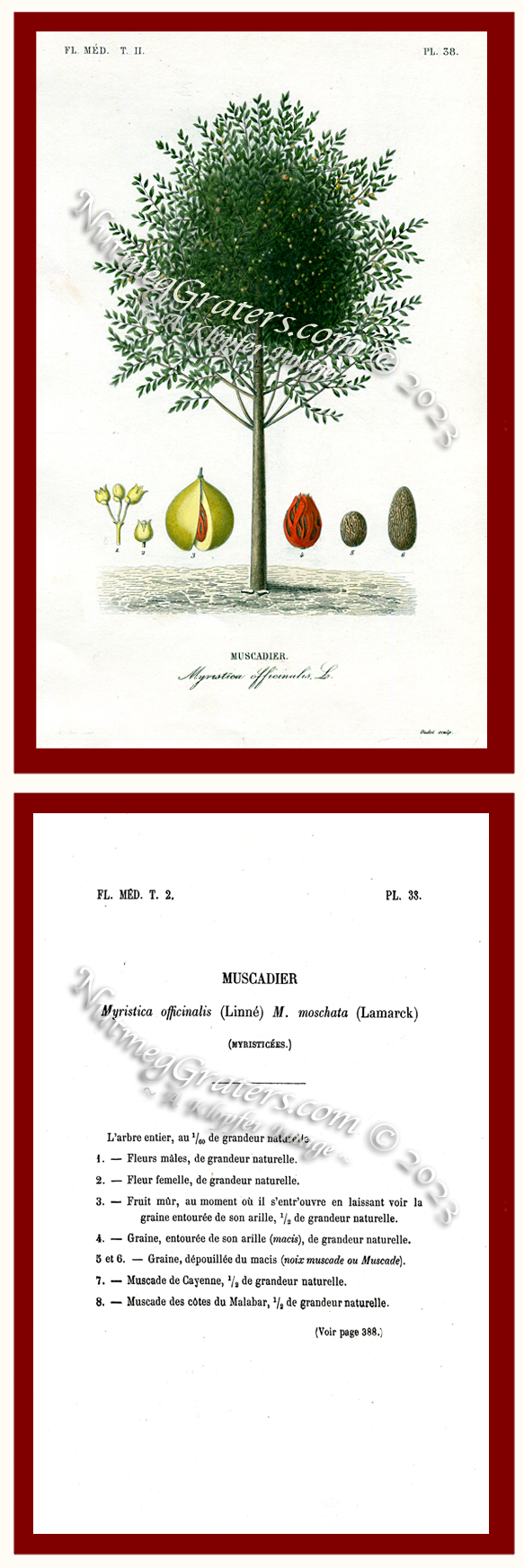NutmegGraters.Com


"Muscadier. Myristica officinalis, L." ~ 1864 ~ Réveil, Dupuis, Gérard, & Hérincq ~ Le Regne Végétal: (…Flore Médicale Et Usuelle, …)
PRINT ENTITLED: "Muscadier. Myristica officinalis, L."
SOURCE: Le Règne Végétal : Divisé En Traité De Botanique Générale, Flore Médicale
Et Usuelle, Horticulture Théorique Et Pratique, (Plantes Potagères, Arbres Fruitiers,
Végétaux D'Ornement) Plantes Agricoles Et Forestières, Histoire Biographique Et
Bibliographique De La Botanique; ~ Atlas Iconographique.
AUTHOR: MM. Aristide Dupuis, Fr. Gérard, O. Reveil, F. Hérincq [et al.].
EDITOR: L. Guérin.
PUBLISHER: Théodore Morgand, Paris.
ARTIST/ILLUSTRATOR:
Oudet. [NOTE: Although not indicted in this illustration, other
printings attribute this engraving as ("painted") by "Maubert, pinx".
VOLUME: Plate 38, with related Text Block Page 38 [AS SHOWN: to the right],
From: Engravings Atlas #2 of 8 Volumes; Accompanied By: 9 Description Text
Volumes Text Volume #2 pgs: 388, 389, 390, 391, & 392; The Full Set That Totals:
"Seventeen Beautiful Volumes".
DATE OF PUBLICATION: Volume 2 ~1864 (entire series completed between 1864-69)
Full duration of publication: 1864 ~ 1871.
SCOPE AND PURPOSE OF PUBLICATION: This comprehensive publication pertains to
botanical study of plants having culinary, medical, industrial and ornamental properties.
PRINT METHOD: Chromolithograph.
PAPER TYPE: Heavy weight bond parchment.
DISCRIPTION:
This monumental reference anthology, Le Règne Végétal : Divisé En Traité De Botanique Générale, Flore Médicale Et Usuelle …, consists of a 17 volume encyclopedia that details culinary, medicinal, industrial and/or ornamental importance of significant plant species. Within its 17 volumes are 8 "folio" Atlases that contain exceptionally detailed and artfully illustrated Botanical engravings "in quarto" size plates, with corresponding descriptive text located on an adjacent page [as shown to the right in "Plates 38"]. The remaining 9 large Text volumes detail in-depth historical and practical accounts among thousands of trees, fruits, seeds, flowers, and mushrooms.[1]
The 17 volumes are organized into six sub-classifications: [1]
Classification 1: Traité de botanique générale (A general botanical treatise) is contained
within 2 Text volumes and 2 Atlas volumes (one of these Atlases has 53 plates, while the
other has 50 plates). All 4 volumes overview plant biology, illustrating parts of flowers,
leaves, roots and seeds.
Classification 2: Flore médicale, usuelle et industrielle (Medical, culinary, and industrial
flora) is introduced within 3 Text volumes and 3 Atlas volumes (each Atlas possessing
50 plates). These 6 volumes provide medical botany pertaining to medicinal herbal
usage from trees, bushes, and plants.
Classification 3: Horticulture ~ Jardin potager et jardin fruitier (Cultivation of vegetable
and fruit gardens) is presented within 1 Text volume and 1 Atlas volume (the Atlas
possessing 56 plates). This Atlas depicts vegetables and fruits, usually with five
varieties per engraved plate.
Classification 4: Horticulture ~ Végétaux d'ornements (Cultivation of Ornamental
plants) is featured within 1 Text volume and 1 Atlas volume (the Atlas possessing
52 plates). This Atlas illustrates ornamental garden flowers, each engraved plate having
multiple floral variations.
Classification 5: Horticulture ~ Plantes agricoles et forestières (Horticulture with
agricultural and forestry plants) is introduced within 1 Text volume and 1 Atlas
volume featuring various trees (the Atlas provides 50 plates).
Classification 6: Récit biographique et bibliographique de l'histoire de la botanique
(Biographical and bibliographical account of the history of botany) in 1 Text volume
containing only 4 engraved plates as illustrations related to the text.
HISTORY:
Le Règne Végétal : Divisé En Traité De Botanique Générale, Flore Médicale Et Usuelle … is an encyclopedic French botanical reference series republished throughout the second half of the nineteenth century. This series borrows from earlier works, and includes the finest engravings by such greats (living or dead) as Corbie, Debray, Lebrun, Lagesse, É. Maubert, L. Noel, Oudet, Pierre, and others. It is important to identify and pay tribute to primary individuals credited for over-site, writing and publishing this entire series as Aristide Dupuis (1823~1883) and Pierre Oscar Réveil (1821-1865); plus main contributors to Atlas Volume 2 being Frédéric Gérard (1806~1857) and François Hérincq (1820-1891). Following are their brief histories:
(1) Aristide Dupuis (1823~1883) is credited as the primary author with this series. He was French botanist, professor of natural history at the Agronomic
Institute of Grignon, produced 101 works during his lifetime.
(2) Pierre Oscar Réveil (1821-1865) is listed the secondary author to the series. He was a French doctor of medicine, pharmacist and botanist who
developed numerous prescriptions and medical formulas; he produced 153 works during his lifetime.
(3) Frédéric Gérard (1806~1857) was a French botanist and annotator, who published 20 significant medical and non-medical works.
(4) François Hérincq (1820-1891) was a French botanist at the Museum of Natural History, editor of L'Horticulture Francais and published 60
works of importance.
(5) Édouard Maubert (1806~1879) was a famous French botanical artist who contributed to botanical books and horticultural journals. He collaborated
with countless important botanist of his time. His work was a major influence on Le Règne Végétal. Within some re-publications of this series,
the "Muscadier. Myristica officinalis, L." illustration (shown here) sometimes credits Maubert as "pinx", the original painter of this image.
(6) Oudet (18??~18??) is shown to be the engraver [ "scupl." ]. An exhausted search was conducted to learn of this engraver. Hundreds of images
were found by this man, but his personal history remains elusive.
_____________________
[1] Florilegius
[KLOPFER article © January 2023]